I was talking about the foam roller in a couple of my previous articles. And the reason is I strongly believe that the foam roller can save you from lots of health issues as well as help you maintain a healthy, flexible and pain-free body.
Articles that also mention foam roller: “How to loosen tight Hamstrings” and “How to manage chronic back pain”
First of all, the foam roller can literally replace a therapeutic massage. As many of you know, I used to be a massage therapist and can confirm that without any doubt. By using a foam roller you are basically getting the same benefits of the therapist at the comfort of your own home, for free (well, once you buy a foam roller, of course, but it lasts forever).
And this is true because the foam roller offers myofascial release, the technique used by many therapists to allow contracted muscles to relax. If you are an athlete or have some chronic muscle pains it is a great idea to start incorporating a foam roller into your daily routine.
Which Foam Roller to Choose?
I have 4 different foam rollers at home. Quite honestly, you don’t have to buy so many. In the beginning, I just was not sure which one I actually need. Usually, you want to start with the softer rollers and progressively go to the firmer ones. But eventually, I highly recommend getting the one from Trigger Point Therapy. It is great for any rolling purposes and will last you a lifetime.
List of Health Benefits of a Foam Roller:
Foam rolling is great for many reasons. So here is the list of some health benefits:
- Increased range of motion. Most of the time the tightness of muscles coupled with the trigger points, and adhesions (aka “knots”) limiting joints from the full range of motion. The foam roller helps to get rid of those knots for better flexibility.
- Increased blood flow to the area. When using a foam roller, you are applying force to your muscles and connective tissue. While applying pressure, blood is squeezed out of that area and then immediately replaced by fresh blood that brings the nutrients and better hydration to the tissue.
- Reduced lactic acid to aid recovery. If you use a foam roller after the workout, it will help prevent the soreness of the muscles. (1)
- Can prevent injury. When the foam roller used regularly, it can prevent many injuries, especially if you are a runner, an athlete or have a job the requires repetitive motion and even sitting at the computer.
- Can be used as a workout tool. There are many ways that the foam roller can be incorporated into the workout. And not only for gaining flexibility, but also for strength training and balancing.
- Can replace a therapeutic massage. If you have no time or money to go to a professional massage therapist, use a foam roller, you will get most of the benefits the therapist can offer.
- The EXTRA Benefit for women – it can improve the appearance of the cellulite, all for free 🙂
What You Need to Know before Using a Foam Roller:

Well, I must warn you first. If you have never used a foam roller before, it is NOT going to be pleasant at the beginning. Actually, it will be VERY uncomfortable and you are going to think that this is the worst you have ever done to yourself. BUT! If you pass that feeling and will continue using a foam roller, I promise, the results will amaze you. It just takes a couple of weeks for the body to get used to it if done every day, or at least every other day.
Beware of the following before you start using your foam roller:
- DO NOT roll directly over the place where you feel the pain. “Go indirect before direct. If you find a spot that’s sensitive, it’s a cue to ease away from that area by a few inches” (2) Rolling on an already inflamed area can increase inflammation, thereby giving you the exact opposite effect you are trying to achieve. (3)
- DO NOT roll too fast. You should use a foam roller moving from one spot to another with controlled slow motion. Otherwise, your muscles will not have enough time to adjust and the roller will not do its job. You will just waste your time.
- DO NOT get stuck on one spot for too long. Once you locate the knot, you should spend no more than 15-30 seconds on that spot. Otherwise, you can damage a nerve or/and the tissue that will lead to more problems.
- Consult your doctor if you are PREGNANT. Foam rolling can cause more harm than good during pregnancy due to hormone relaxin that allows the body to relax the joints. Precautions should be taken, especially if you have never done a foam rolling before.
- Consult your doctor if you have OSTEOPOROSIS. Risk of breaking a bone could be greatly increased by foam rolling for those with osteoporosis and brittle bones.
- Start from the bottom and go up. This one is not must, but it is the best way to use a foam roller. Begin from the feet and slowing move up. All misalignments in the body start from your feet and then go up. If you have any muscle issues, you need to start looking for a cause from the bottom. By the way, most of the back problems come from the tightness in the hips and legs. Read more “How to manage chronic back pain”
Which Muscles to Foam Roll?
Note: the following order is best to follow as it appears on the list, always starting from the bottom up. You can skip some parts of the body and concentrate on the ones that are the tigh
If you like this content, subscribe to my newsletter 👇
Calves
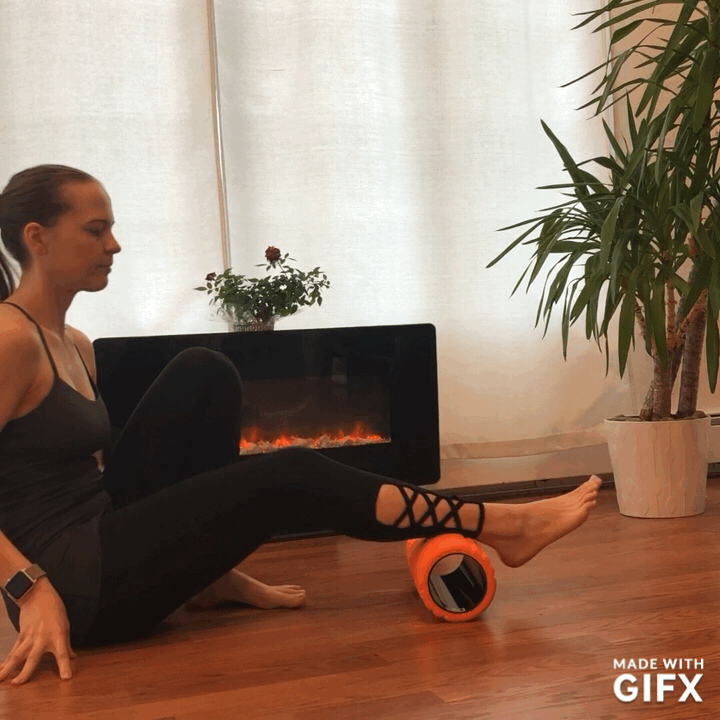
- Place the right calf on the foam roller
- Cross your ankles by placing the left over the right one (this creates more pressure on the calf. If that feels too much, remove the top leg and foam roll the right calf alone)
- Support yourself with the hands on the floor behind your back
- Lift the hips off the floor and start rolling up the calf
- When starting to feel tense spot, stay over it for 15-30 seconds
- Switch sides
Hamstrings
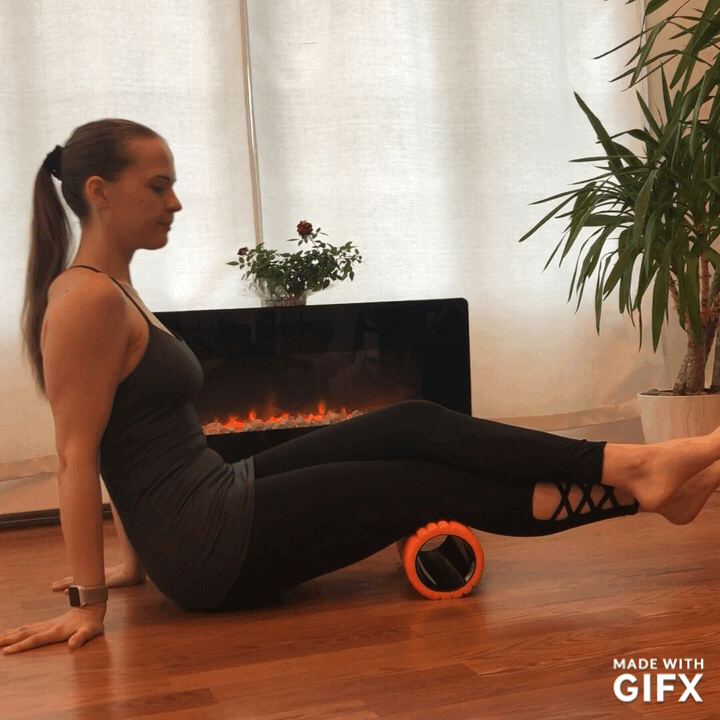
- Place the foam roller under the back of your right thigh
- Support yourself with the hands on the floor behind your back
- Place the left leg over the right to create more pressure
- Lift the hips off the floor and start rolling up towards the gluts
- Keep leaning with your hips towards the right side to create more pressure on the hamstrings against the roller
- If you feel tense spots, stay there for 15-30 seconds
- Switch the sides
Quads
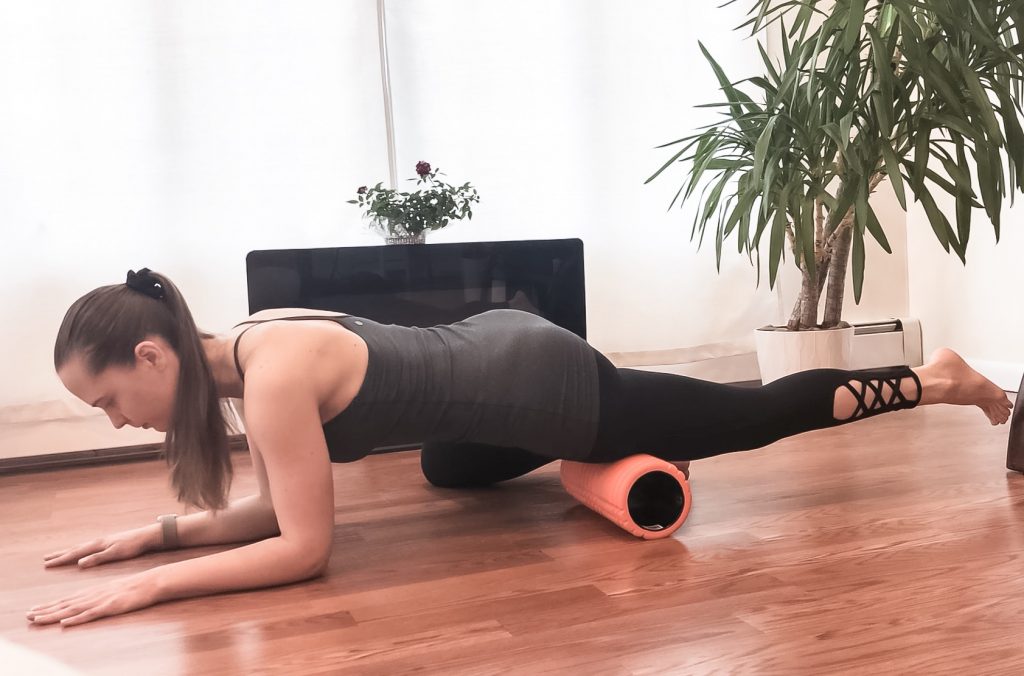
- Lay with your thighs on the foam roller, starting slightly higher than the knee (you can roll both thighs together or one thigh at a time)
- Support yourself on the forearm against the floor
- Start slowly rolling up towards the hips
- Slowly walk your elbows as needed
- If you feel any tense spot, stay over it for 15-30 seconds
IT Band
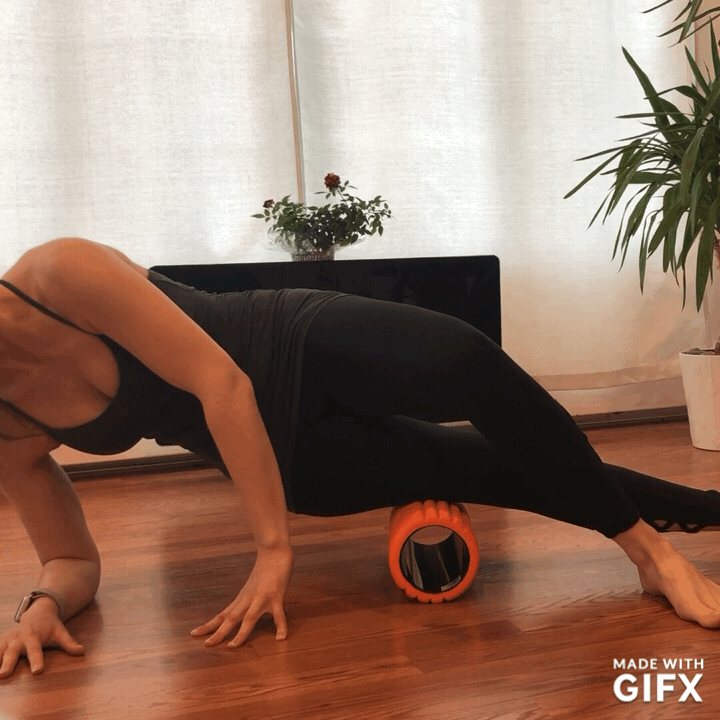
- Lay with the side of your right thigh on the foam roller, slightly higher than the side of the knee
- Right forearm on the floor, elbow directly over the shoulder
- Left hand (or fingertips) on the floor for extra support
- The left foot is in front pressed against the floor, the knee is bend
- Start rolling up until the hip bone (don’t roll over the bony part of the hip, you will create more inflammation)
- If you feel tense spots, stay there for 15-30 seconds
- Switch the sides
Adductors
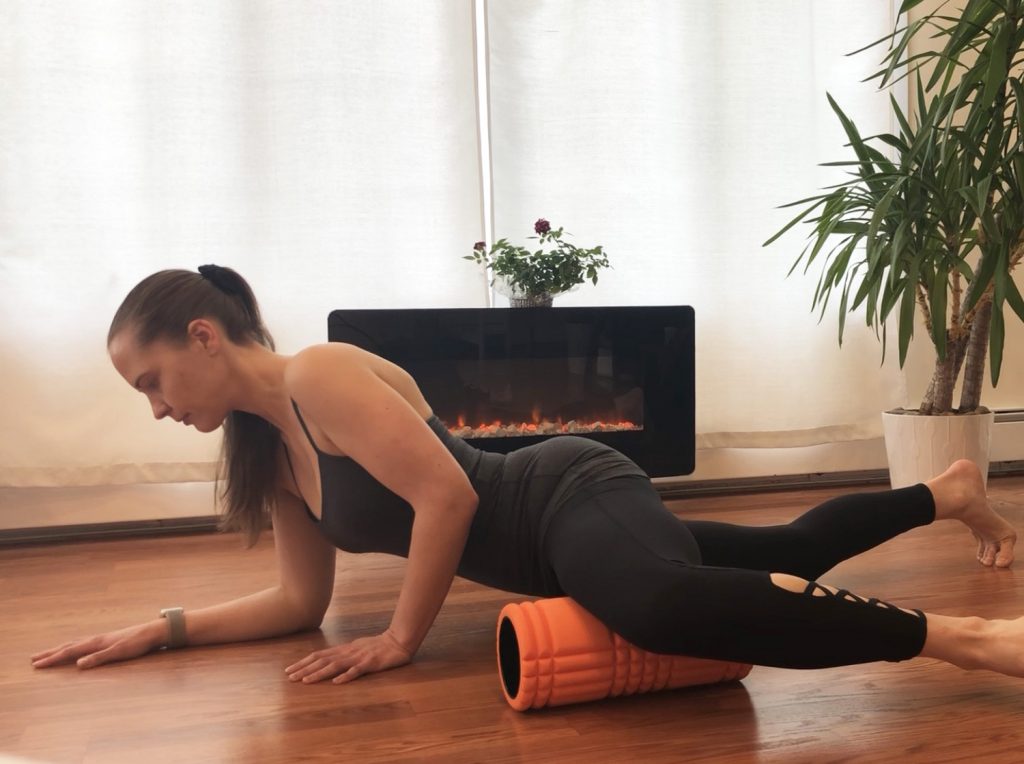
- Bend one knee and place the foam roller on the inner part of the thigh
- The other leg is straight
- Support yourself with one forearm and the other hand against (or you can place both elbows on the ground)
- Start rolling the inner thigh up towards the groin
- Be careful, this area might be very sensitive!
- Switch the sides
Gluteal Muscles
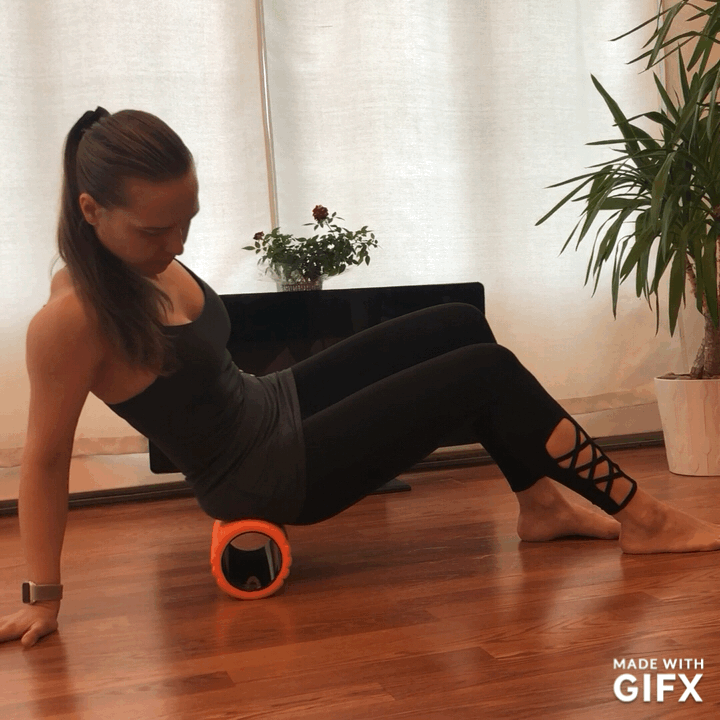
- Sit with the right side of your gluts on the foam roller
- Support yourself with the right hand on the floor behind your back
- Both feet on the ground
- Start rolling up and down
- Stay on the spots that feel tense for 15-30 seconds
- Switch the sides
Piriformis
This muscle is to blame for many cases of Sciatica and lower back issues. If you suffer from those, try to include the next exercise in your daily routine. Although precautions need to be taken. Do not exacerbate the inflammation that is already there. If you experience pain during or after the foam rolling, stay away from this exercise, but continue doing others. When the condition improves, you can try it again. Eventually, releasing the tension in Piriformis should tremendously improve your condition.
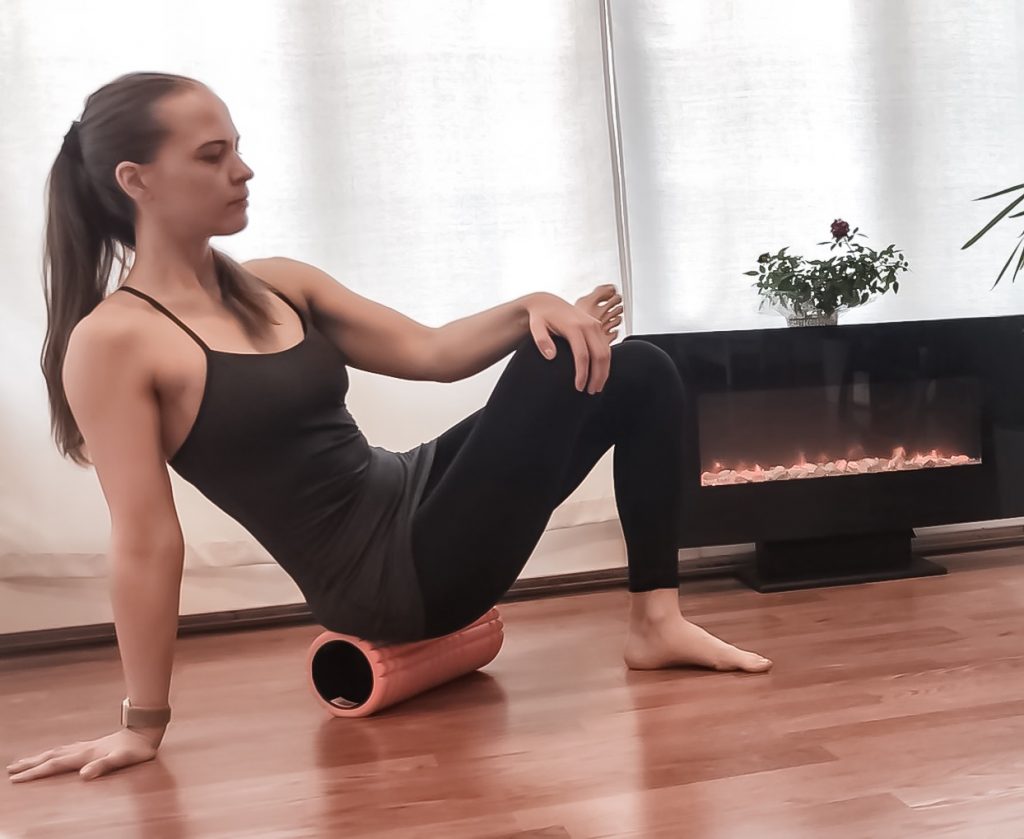
- Create a figure 4 by placing the right ankle over the left thigh
- Support yourself with the right hand behind your back on the floor
- Sit on the foam roller with the right side of your glutes
- Lean slightly towards the right side with your torso
- Start pulling right knee towards your torso until you feel the stretch in the buttocks
- Keep leaning forward and to the right with the torso
- Stay for 15-30 seconds
- Switch the sides
Lats
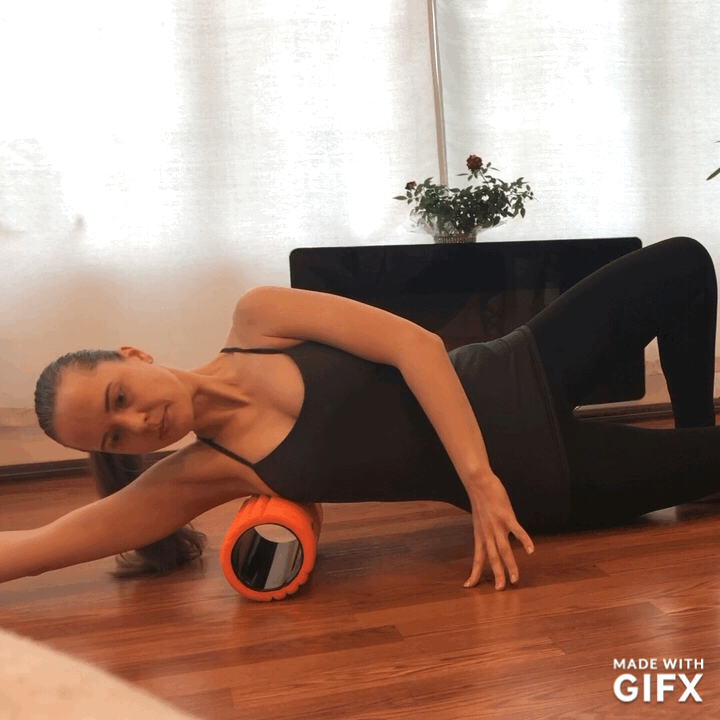
- Place the foam roller under your right armpit more towards the back
- Extend your right arm up
- Right leg straight
- Left hand in front and left foot behind are on the floor for support
- Start rolling up and down
- If you feel tension, stay for 15-30 second
- Switch the sides
Middle and Upper Back
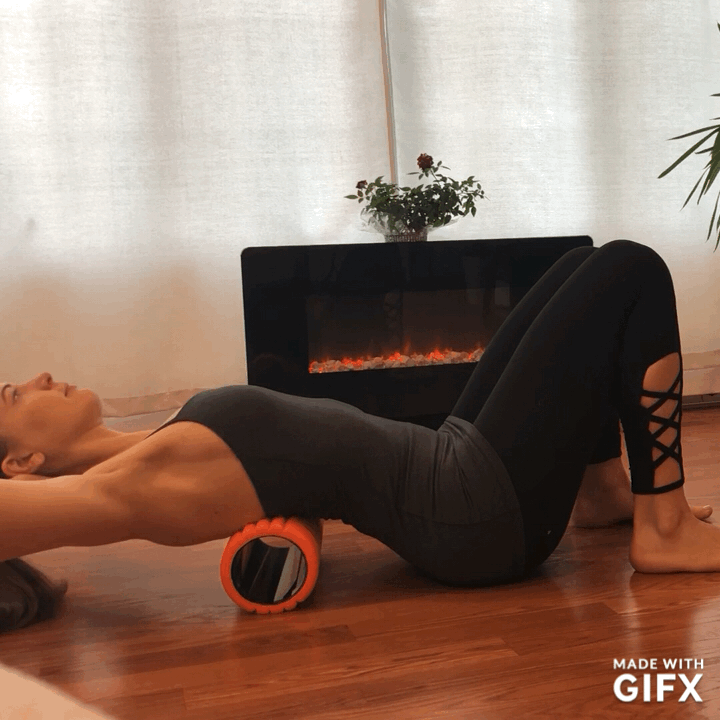
- Place the foam roller at the lower ribs
- Interlace the hands behind your head for support
- Press both feet against the floor
- Lift the hips up and start walking your feet while rolling up towards the neck
- Stay at any spots that feel tense for 15-30 seconds
- Repeat several times, rolling up and down
NOTE: I do not recommend to use a foam roller on the lower back, although lots of people do. In case you choose to use a foam roller on your lower back, I recommend consulting your physician first.
You can also use a foam roller on the arms, rolling biceps, triceps and deltoid muscles. These can benefit anyone who is doing weight lifting or has some job that requires repetitive upper body motions.
Conclusion

When using a foam roller you will go from “I hate it” to ” I love it”. You will hate it at first because it does create lots of uncomfortable feelings. But once you pass the stage when every single spot hurts, you will experience all the benefits that come along. And little by little you will be gaining more flexibility while reducing many body pains.
I personally love to use a foam roller, while watching my favorite TV shows. The time goes by so quickly and by the end of the show, you get a more flexible, healthier body.
Stay Happy and Healthy!
Pin for Later 👇
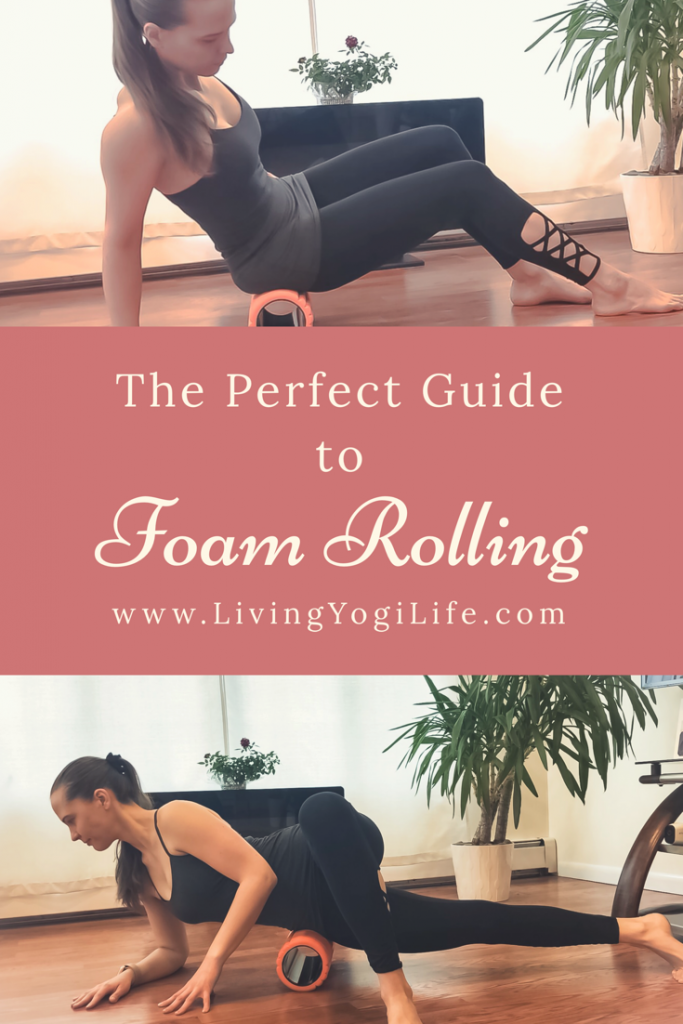
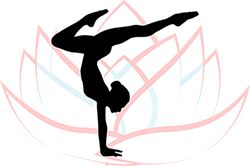
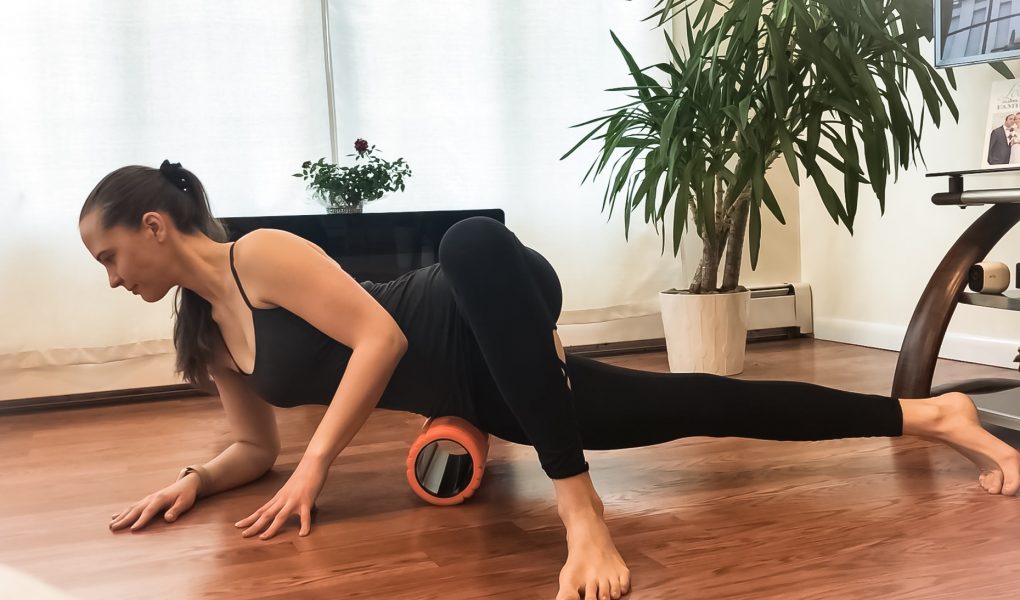















[…] Use a foam roller to loosen front of the thighs, back of the thighs, glutes area and calves. This will help to achieve better results in flexibility and getting rid of tightness in the body. The article on how to use a foam roller can be found here. […]
[…] Use a foam roller to relieve the tension from the tight spots, including your back, front of the thighs, calves and hip rotators. Read the article about how to use a foam roller […] […]
Great article to release pain! Thank you.
I absolutely love my foam roller!! It relaxes me so much after a good workout, or even on days I don’t workout! Good tips!
UMMMM….ok, this looks awesome. Never seen one, but now I am TOTALLY intrigued! 🙂 THANKS!!!!!
Great instructional videos on how to use it! I want to try it out!
Wonderful detail for those new to “rolling”. Love the GIFX clips!
Thank you, Suzan!
Thank you for including the videos! That helps immensely. Also, I appreciated this tip: Rolling on an already inflamed area can increase inflammation, thereby giving you the exact opposite effect you are trying to achieve. Very good to know, as I have a tendency to want to push right where it hurts the most!
Happy to provide this information!
My daughter was a dancer so we have foam rollers at home. She highly recommends them for all the reasons you point out too!
You have given me incentive to try this in the future!
oh my gosh!! I can not live without my foam rollers!! I have two.
Ok so now this is on my mother’s day gift wish list!
💕That’s a wonderful gift!💕
Thanks! I’ll be sure to share this with my hubby since he uses the form rollers.
I loved the videos – that helps so much when you try to picture what to do. I use foam rolling quite frequently with my running to help reduce the chances of injury, and it hurts so good! The tips you gave definitely will improve my use of it, though – especially the one about if it hurts it is a sign to start a few inches away.
Happy to give some helpful information. And cannot agree more, it does “hurts so good” haha 😂
This is such a great article. I love/hate to foam roll. However, it keeps me running, so I keep doing it!
Thank you, Heather!
I’ve never thought about using one until I saw your post. I think I’d really like it for my upper back. Thanks for the thorough overview on getting started!
Of course, Stacey! And I also love it the most on the upper back. It really helps a lot in releasing the tension from sitting at the computer.
The only thing that saved me when I trained for the few marathons I did was my foam roller. I need to bring it back into my daily routine.
I do believe so! It also saved me a lot, in so many situations. It really works its magic!
I always love your videos, Anna! They are so helpful, and you do such a nice job with them! I have thought about using a foam roller to help with my fibromyalgia pain, especially the one you have here in the post. My daughter is a runner and uses foam rollers religiously, so I know they help!
Thank you, Ramae! Just knowing about your hip, please be careful with the foam roller on the lower body. Maybe ask your doctor if that is ok to roll your lower body. But I am sure you can definitely use it on the upper body! Hope it helps with pain management.
I really love this idea of stret6 and flexing while watching my favorite show. I think I’ll give it a try.
Happy to share the good ideas! 💕
My best friend swears by them! Thank you for the tips!
I bought a foam roller a few months back and never put it to use. Thanks for a great article and reminding me to get going with it.
Great instructional videos. You made it look much easier than I’m sure it would be for my clumsy self, but I am intrigued.
Awesome post! I really liked your mini tutorial videos within the blog. I had to use one of these in physical therapy once and loved it!! Everyone should try this.
I really need a foam roller! After having babies, I am pretty much sore all the time.
Interesting read. I have wondered about these and I see a lot of dancers use them. Now I feel like I understand their purpose. Thank you!
I have a foam roller and now I feel the need to dig it out of storage. Thanks for the well-done post!
Happy that your foam roller is now going to have a great use! 🙂
Ok – my favorite post so far! I have a foam roller and a trigger point hard roller – I agree it hurts at first- but it is totally worth it, especially if you run a lot!
This a a great posts with lots of helpful information. After reading this, now I feel like I need to buy one. Great videos too.
Thank you, Carolina!
Very informative post!!! Thank you for sharing the techniques and products to be successful.
I’m still surprised at how helpful foam rollers can be! I didn’t think they would do much the first time I held one, but OMG when I used it on my lower back, all I can say is that I’m grateful I was already on the floor whenever it stretched a very tender muscle!
What great tips. I love my foam roller. I’m glad you did the little videos. There is a learning curve with rollers.
Very helpful article! I suffer from chronic neck and shoulder pain. Going to check out whether a foam roller could help. Thank you!
I can see how this would be of benefit ~ especially with your explaining blood flow. Definitely going to consider this for my morning routine.
Thanks for great info and the videos. I’d love to try a foam roller. You e encouraged me to do so.
I could totally use one of these right now! Used to use them at my Chiro’s office hurt like crazy but did so much good, I am back to working out early morning again so I may have to get one of these shortly. Thank you so much for sharing! 🤗